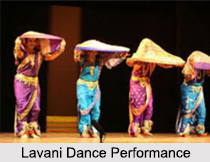 Lavani which is well known for its powerful rhythm is one of the most popular folk dance forms of India. It is a genre of music popular in the state of Maharashtra and is a combination of traditional song and dance, which is particularly performed to the beats of Dholak. This dance is also practiced in southern Madhya Pradesh. Lavani dance art form has contributed largely to the development of Marathi folk theatre. Lavani can also be defined as a romantic number sung by a woman who is waiting for her lover to accept her.
Lavani which is well known for its powerful rhythm is one of the most popular folk dance forms of India. It is a genre of music popular in the state of Maharashtra and is a combination of traditional song and dance, which is particularly performed to the beats of Dholak. This dance is also practiced in southern Madhya Pradesh. Lavani dance art form has contributed largely to the development of Marathi folk theatre. Lavani can also be defined as a romantic number sung by a woman who is waiting for her lover to accept her.
History of Lavani
The word Lavani did originate from the term Lavanya which means beauty. Quite ideally therefore beauty, splendour, magnificence coupled with the aura of sheer feminism laces this classical folk dance form while offering it a colossal identity of its own. Although the exact date of the origin of Lavani is still vague, however it is said that in the long gone era this dance form did originate as a typical form of entertainment and also as a boost to the exhausted soldier. Maharashtra was once a battle torn state, and Lavani dance served as a mode of entertainment and morale booster for the tired soldiers during the 18th and 19th century. The dance reached peak popularity during the Peshwa rule, when it was granted royal patronage by the ruling elite. Marathi poets like Honaji Bala, Ramjoshi, Prabhakar, etc. took Lavani to new heights.
Performance of Lavani
Lavani is like a musical discussion and is therefore a harmonious blend of tune, timber, dance, song and tradition. The enchanting beats of the Dholak coupled with the zing of the colourful dance form, adds an articulate dimension to this particular folk music while making it jazzier. The tempo of Lavani is pretty fast and is often unified with the rhythmic feet of the colourful dancers. The themes of Lavani folk dance concentrate on myriad subject matters like society, religion, politics and romance. Some castes of Maharashtra like Mahar, Kolhati, Kumbhar, and Matang mainly perform Lavani.
The Lavani dance is developed into two forms, namely Phadachi Lavani and Baithakichi Lavani. The form essayed before a large audience in a theatrical atmosphere is known as Phadachi Lavani. Baithakichi Lavani is performed in private and is inclined more towards classical tunes and modes.
Costumes of Lavani
The female performers of this dance dress themselves in a 9-yard long saree called Nauvari and tie their hair in a bun. They also wear heavy jewelleries like necklace, ear rings, payal, kamarpatta (a belt at waist), bangles etc to complete their look. Bindi is an important accessory to this dance. The participants usually put a large bindi of dark red colour on their forehead.



















